Occupational environment monitoring of a medical mask manufacturing factory
99,000 ₫
Note: The above price is calculated for one sample, and the price may fluctuate depending on the area of the environment to be monitored and market movements. For more accurate pricing support, please refer to the price list or contact our consulting staff directly.
Monitoring the environment of a medical mask manufacturing factory is a session of collecting, analyzing, and evaluating factors at the workplace that may harm workers health.
Table of Contents
Toggle1. Overview of Medical Mask Manufacturing Factory
a. What is a medical mask manufacturing factory?
A factory for medical mask manufacturing is a facility specialized in manufacturing and packaging medical masks. This factory usually applies strict processes and standards to ensure the quality and safety of the final products.
The main raw materials for medical mask manufacturing include non-woven fabric, ear loops, plastic nose bridges, and other components. The factory purchases these materials from reliable suppliers and conducts quality inspections before use.

b. Production stages in a medical mask manufacturing factory
Production stages in a medical mask manufacturing factory include the following steps:
- Raw material preparation: The factory prepares necessary raw materials such as non-woven fabric, ear loops, plastic nose bridges, metal nose clips, and other components.
- Cutting and processing non-woven fabric: Non-woven fabric is cut into small pieces with appropriate sizes and shapes to form the protective layers of masks. This process includes precise cutting according to patterns, coloring (if necessary), and surface treatment to enhance water resistance or anti-static properties.
- Component assembly: Cut fabric pieces are assembled with other components such as ear loops and plastic nose bridges to form complete masks. Components are joined by methods such as welding, adhesive bonding, or sewing.
- Shaping and folding: After assembly, masks are shaped to have proper dimensions and form. Edges and corners may be folded to fit the face snugly and improve mask fit.
- Quality inspection: At each critical stage of production, quality checks are conducted to ensure masks meet safety and quality standards. Factors such as filtration efficiency, degradation resistance, durability, and water resistance are inspected.
- Packing and boxing: After quality inspection, medical masks are packed in small bags or large boxes. Packaging includes individual wrapping or multi-mask boxes. Product labels and usage instructions are attached to the packaging.

c. Machinery used in a medical mask manufacturing factory
Common machinery used in medical mask manufacturing factories includes:
- Automatic cutting machines: Used to cut non-woven fabric into pieces with required sizes and shapes.
- Welding machines: Used to weld fabric pieces together or attach components like ear loops and plastic nose bridges.
- Shaping and folding machines: Used to shape masks and create folds for a proper fit to the face.
- Sewing machines: Used to sew mask components together, especially during assembly and final packaging.
- Quality inspection machines: Include devices to test filtration efficiency, degradation resistance, durability, and water resistance.
- Packing machines: Used to pack masks into individual bags or multi-mask boxes.
- Printing and labeling machines: Used to print and attach necessary information on the mask packaging.
- Conveying and stacking machines: Used to transport and stack finished masks into warehouses or transport vehicles.

d. Occupational diseases for workers in a medical mask manufacturing factory
Workers in a medical mask manufacturing factory may encounter the following occupational diseases:
- Respiratory diseases: Continuous exposure to dust from non-woven fabric and chemicals during manufacturing may cause respiratory issues such as bronchitis, pneumonia, or asthma.
- Skin diseases: Chemicals used in fabric treatment may cause skin irritation, dermatitis, or allergies. Long-term exposure can lead to skin damage.
- Musculoskeletal disorders: Working in industrial environments, especially in physically demanding positions, may cause continuous muscle strain and problems with the spine and joints, such as back pain, spinal degeneration, or arthritis.
- Vision problems: Production processes may involve strong light or chemicals that irritate the eyes, causing conjunctivitis, keratitis, or blurred vision.
- Hearing problems: Continuous noise in the production environment may damage hearing, leading to hearing loss or tinnitus.
To prevent these occupational diseases, labor protection measures must be applied, including personal protective equipment, proper workplace hygiene, hazardous substance control, and occupational safety and health training for workers.

e. Types of products in a medical mask manufacturing factory
Common medical mask types include:
- 3-layer medical masks: Standard masks made from three layers of non-woven fabric. The outer and inner layers are typically non-woven fabric, while the middle layer may be a filter or water-resistant layer. Used for daily protection against bacteria, viruses, and small particles.
- N95 medical masks: Rated to filter 95% of small particles according to the N95 standard by the United States Occupational Safety and Health Administration (OSHA). Used mainly in healthcare and environments with airborne pollutants.
- FFP2 medical masks: European standard similar to N95, filtering at least 94% of small particles, dust, bacteria, and viruses. Common in healthcare and polluted work environments.
- Medical masks with exhalation valve: A version of N95 or FFP2 masks with an exhalation valve for easier breathing. The valve allows exhaled air to exit easily, reducing breathing resistance and fatigue during prolonged use. However, valves do not prevent the wearer from spreading bacteria or viruses to the surrounding environment.

2. Overview of Occupational Environment Monitoring Services
a. What is occupational environment monitoring in a medical mask manufacturing factory?
Occupational environment monitoring (or workplace environment measurement) in a medical mask manufacturing factory involves collecting, evaluating, and analyzing workplace environmental factors to implement timely interventions, minimize health risks, and prevent occupational diseases. Monitoring is mandatory for medical mask manufacturing factories.
This monitoring plays a crucial role in protecting and promoting worker health because employees are the main resource and directly generate profits for the enterprise. Workers frequently exposed to hazards exceeding permissible limits are at risk of health problems and occupational diseases.
REGISTER FOR OCCUPATIONAL ENVIRONMENT MONITORING SERVICE
b. An Toan Nam Viet’s occupational environment monitoring program
An Toan Nam Viet’s occupational environment monitoring program is developed by engineers specializing in occupational safety and environmental protection. Aimed at ensuring worker health and safety, the program uses modern measurement methods to monitor air quality, water, microclimate, physical factors, and dust in the workplace. This program is essential for maintaining a safe working environment and protecting worker health.
Additionally, the program plays an important role in researching and developing solutions to improve workplace environmental quality. With the dedication and professionalism of its experts, An Toan Nam Viet’s proprietary program is a breakthrough in occupational safety and environmental management in Vietnam.

c. Standardization in workplace measurement procedures
Standardization in An Toan Nam Viet’s measurement procedures ensures accuracy and reliability. The program uses standards recognized by the Ho Chi Minh City Department of Health. This ensures collected data is reliable for workplace evaluation and for decisions to improve working conditions and protect worker health.
Standardized procedures also guarantee that measurements are conducted by highly qualified monitoring specialists with years of experience, giving managers confidence in An Toan Nam Viet’s results for precise and valuable decision-making.
Applying standardization demonstrates An Toan Nam Viet’s commitment to a safe working environment and protecting worker health, while contributing to the development of occupational safety and environmental management in Vietnam.
d. Reporting results of medical mask manufacturing factory monitoring
Monitoring results are compiled according to Form No. 04, Appendix III, issued with Decree 44/2016/ND-CP and prepared in 2 copies: one for the enterprise that signed the monitoring contract, and one retained by the monitoring organization.
Monitoring records are stored indefinitely according to legal regulations.

e. Frequency of occupational environment monitoring according to law
According to Clause 2, Article 18 of the Law on Occupational Safety and Hygiene 84/2015/QH13, employers must conduct occupational environment monitoring at least once a year to evaluate harmful factors.
f. Deadline for submitting monitoring reports according to law
The deadline is before December 31 each year. Enterprises must submit monitoring reports to the Department of Health at the location of the production facility and where employees are working.
When there are changes in technology, manufacturing processes, or when upgrading facilities that may introduce new hazards, enterprises must update occupational hygiene records regarding harmful factors requiring monitoring.
g. Penalties for violations of occupational environment monitoring for employers
According to Article 27 of Decree No. 12/2022/ND-CP dated January 17, 2022, on administrative penalties in labor, social insurance, and overseas employment contracts for Vietnamese workers:
- Clause 2: Fines from 2,000,000 – 5,000,000 VND for employers who fail to publicly inform employees at the monitoring site and management offices about results immediately after receiving monitoring and hazard assessment outcomes.
- Clause 3: Fines from 20,000,000 – 40,000,000 VND for employers who fail to perform occupational environment monitoring to control health hazards as required by law.
- Clause 4: Fines from 40,000,000 – 60,000,000 VND for employers who collude with monitoring organizations to commit fraud in monitoring activities, without criminal liability.
3. Harmful Environmental Factors for Workers in Medical Mask Factories
Workers in medical mask factories may be exposed to the following harmful environmental factors:
- Dust and fine particles: The production process of medical masks can generate dust and fine particles from non-woven fabrics, chemical components, and processing activities. Inhaling these particles poses risks to the respiratory system and may cause irritation, pneumonia, or other respiratory problems.
- Chemicals: Some chemicals used in medical mask production can be hazardous to health. These may include solvents, cleaning agents, coloring agents, or other additives. Exposure can cause skin, eye, respiratory, or nervous system irritation.
- Noise: The working environment in medical mask factories may have noise from machinery, air compressors, cutting machines, and other processing equipment. Continuous and excessive noise can cause stress, sleep disturbances, increased risk of accidents, and negatively impact workers’ mental and nervous health.
- Temperature and humidity: Medical mask factories may have hot environments, high humidity, or varying working conditions. Poor environmental conditions can cause discomfort, fatigue, dehydration, and affect overall health and work performance.
- Lighting: Certain production stages may require strong lighting or specialized lighting technologies. Continuous exposure to intense light can lead to eye strain, visual fatigue, and vision problems.
REGISTER FOR WORKPLACE ENVIRONMENT MONITORING SERVICE
4. Measures to Improve Working Conditions in Medical Mask Factories
To improve working conditions in medical mask factories and protect workers’ health, the following measures can be applied:
- Ensure ventilation and air management systems: Provide an effective ventilation system to maintain air circulation and remove dust, chemical fumes, and other pollutants. This may include using fans, air purifiers, or exhaust systems.
- Use personal protective equipment (PPE): Ensure workers are provided with and properly use suitable PPE such as masks, gloves, safety goggles, protective clothing, and safety shoes depending on job type and exposure risk. PPE helps protect workers from dust, chemicals, and other environmental hazards.
- Minimize noise exposure: Use technical measures such as soundproofing, insulation, and regular maintenance to reduce workplace noise. Provide hearing protection such as earplugs or noise-canceling headphones to safeguard workers’ hearing.
- Maintain proper temperature and humidity: Ensure a comfortable working environment regarding temperature and humidity. Use air conditioning or other measures to maintain reasonable and comfortable conditions.
- Occupational safety and health training: Ensure all workers are trained on occupational safety and health, including safe work procedures and proper use of personal protective equipment.
- Periodically conduct workplace environment monitoring in factories, collect and analyze harmful factors, and adjust measures to reduce hazards and prevent occupational diseases for workers.
5. Benefits of Periodic Monitoring in Medical Mask Factories
An Toan Nam Viet provides businesses with excellent benefits when using workplace environment monitoring services in accordance with Decree 44/2016/ND-CP on managing and controlling harmful factors in working environments affecting workers.
- Businesses can proactively control harmful factors in their workshops or factories.
- Receive recommendations on measures to reduce harmful factors and improve the quality of the working environment.
- Indirectly protect human resources, the main factor in enterprise development.
- Minimize the impact of occupational diseases on workers’ health, reducing future treatment costs.
- Improved worker health leads to higher product quality and ensures production output.
- Comply with labor safety regulations and avoid legal risks.
- Enhance professionalism and reputation, elevating the enterprise’s brand.
Nam Viet’s environmental monitoring service is a solution to reduce occupational disease risks, contributing to a clean and high-quality working environment.

6. Nationwide Workplace Environment Monitoring Center
Nam Viet Workplace Environment Monitoring Center is a professional unit specializing in monitoring and measuring workplace environmental quality throughout all provinces of Vietnam. With an experienced team of monitoring specialists, the center uses modern measuring equipment to ensure accuracy and reliability.
In addition to monitoring services, the center assists clients in planning, handling, and tracking workplace environmental issues. Following the motto “customer-centric,” the center prioritizes client satisfaction, meets all client needs, and provides the best solutions for businesses.
REGISTER FOR WORKPLACE ENVIRONMENT MONITORING SERVICE
With investment in technology, equipment, and personnel, Nam Viet’s monitoring center has become a reputable unit in workplace environment monitoring in Ho Chi Minh City, with objectives including:
- We always prioritize brand reputation and service quality.
- We provide clients with the best and most suitable solutions.
- Alongside a team of experienced Masters and Engineers committed to environmental protection and business benefits.
- By working with Nam Viet Environmental Monitoring, companies receive professional service from experts in the field and the best cost advantages.
The workplace environment monitoring process at Nam Viet includes:
- Before monitoring, all machinery and equipment are calibrated according to legal regulations.
- Implement the complete monitoring process as committed to the Department of Health.
- Report monitoring results honestly to employers.
- If results indicate unsafe conditions, Nam Viet will provide solutions, and the enterprise will implement:
- Measures to improve working conditions, minimize harmful factor impacts, and prevent occupational diseases.
- Health check-ups to detect occupational and work-related diseases early for employees in unsafe environments.
- Provide in-kind benefits to employees according to labor laws.

7. Workplace Environment Monitoring Service Price List
To help businesses perform workplace environment monitoring professionally and effectively, Nam Viet provides clients with a quality and reasonably priced service price list.
- Our price list provides detailed information on the costs of monitoring services we offer, including transportation, measurement, analysis, and reporting. Clients can trust the accuracy and reliability of our monitoring reports.
- We commit to offering the most competitive and reasonable prices in the market and are always ready to answer questions about monitoring services quickly and professionally.
- With Nam Viet’s price list, clients can easily choose service packages that meet their needs. We are committed to delivering the highest satisfaction with professional service quality.
No comments yet


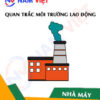
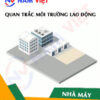
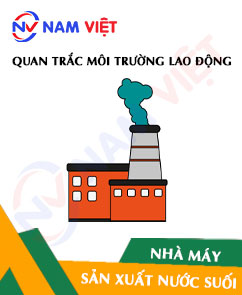



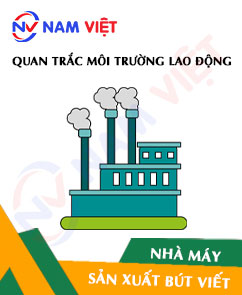
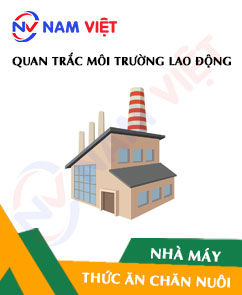

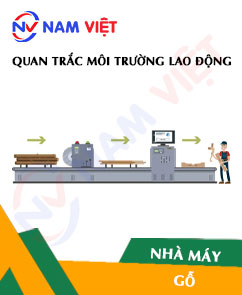
Review Occupational environment monitoring of a medical mask manufacturing factory
There are no reviews yet.